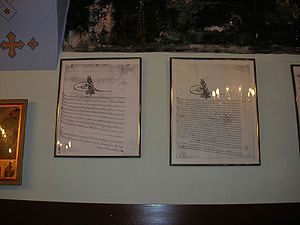
Firman
Encyclopedia
A firman is a royal mandate or decree issued by a sovereign in certain historical Islamic states, including the Ottoman Empire
, Mughal Empire
, State of Hyderabad, and Iran
under Shah Mohammed Reza Pahlavi. The word firman comes from the meaning "decree" or "order". In Turkish
it is called a .
 Firmans were gathered in kanun
Firmans were gathered in kanun
, which were codes, kanun from the Hellenic
word kanon (κανών) meaning rule or rules. The kanun were "a form of secular and administrative law considered to be a valid extension of religious law as a result of the ruler's right to exercise legal judgement on behalf of the community."
in Egypt
.
report that the administrative officials charged with the collection of taxes come at a later date than they are supposed to and demand more money than the value assessed. They also make illegal demands for additional food supplies.
on the Sinai Peninsula
in Egypt. This monastery is Greek Orthodox and constitutes the autonomous Sinai Orthodox Church. The firman bears the hand print of the Prophet Muhammad
, and requests the Muslims do not destroy the monastery for God-fearing men live there. To this day there is a protected zone around the monastery administered by the Egyptian government, and there are very good relations between the 20 or so monks, mainly from Greece, and the local community there.
The Mughal Emperor Akbar is known for issuing Firman's of all categories that eventually strengthened the Mughal Empire
and its administration for centuries to come.
for official permission from the Egyptian Department of Antiquities to carry on an excavation. A similar authority was cited by Austen Henry Layard
for excavations at Nimrud
which he mistakenly believed was Nineveh
.
Ottoman Empire
The Ottoman EmpireIt was usually referred to as the "Ottoman Empire", the "Turkish Empire", the "Ottoman Caliphate" or more commonly "Turkey" by its contemporaries...
, Mughal Empire
Mughal Empire
The Mughal Empire , or Mogul Empire in traditional English usage, was an imperial power from the Indian Subcontinent. The Mughal emperors were descendants of the Timurids...
, State of Hyderabad, and Iran
Iran
Iran , officially the Islamic Republic of Iran , is a country in Southern and Western Asia. The name "Iran" has been in use natively since the Sassanian era and came into use internationally in 1935, before which the country was known to the Western world as Persia...
under Shah Mohammed Reza Pahlavi. The word firman comes from the meaning "decree" or "order". In Turkish
Turkish language
Turkish is a language spoken as a native language by over 83 million people worldwide, making it the most commonly spoken of the Turkic languages. Its speakers are located predominantly in Turkey and Northern Cyprus with smaller groups in Iraq, Greece, Bulgaria, the Republic of Macedonia, Kosovo,...
it is called a .
Origins of firmans in the Ottoman Empire
In the Ottoman Empire, the Sultan derived his authority from his role as upholder of the Shar'ia, but the Shar'ia did not cover all aspects of Ottoman social and political life. Therefore, in order to regulate relations and status, duties and dress of aristocracy and subjects, the Sultan created firmans.Organization

Qanun
Qanun refers to laws promulgated by Muslim sovereigns, in particular the Ottoman Sultans, in contrast to shari'a, the body of law elaborated by Muslim jurists. It comes from the Greek word kanon...
, which were codes, kanun from the Hellenic
Greek language
Greek is an independent branch of the Indo-European family of languages. Native to the southern Balkans, it has the longest documented history of any Indo-European language, spanning 34 centuries of written records. Its writing system has been the Greek alphabet for the majority of its history;...
word kanon (κανών) meaning rule or rules. The kanun were "a form of secular and administrative law considered to be a valid extension of religious law as a result of the ruler's right to exercise legal judgement on behalf of the community."
Firman of Sultan Murad (26 October – 23 November 1386)
In this firman, Sultan Murad I recognises a decree created by his father Sultan Orhan (ca. 1324-60). He gives the monks all they owned during his father's reign, ordering that no one can oppress them or claim their land. The firman is kept at the Monastery of Saint Paul the AnchoriteMonastery of Saint Paul the Anchorite
The Monastery of Saint Paul the Anchorite in Egypt is a Coptic Orthodox monastery located in the Eastern Desert, near the Red Sea mountains. It is about south east of Cairo. The monastery is also known as the Monastery of the Tigers....
in Egypt
Egypt
Egypt , officially the Arab Republic of Egypt, Arabic: , is a country mainly in North Africa, with the Sinai Peninsula forming a land bridge in Southwest Asia. Egypt is thus a transcontinental country, and a major power in Africa, the Mediterranean Basin, the Middle East and the Muslim world...
.
Firman of Sultan Mehmed IV (1648–1687)
In this firman, the monks of Mount AthosMount Athos
Mount Athos is a mountain and peninsula in Macedonia, Greece. A World Heritage Site, it is home to 20 Eastern Orthodox monasteries and forms a self-governed monastic state within the sovereignty of the Hellenic Republic. Spiritually, Mount Athos comes under the direct jurisdiction of the...
report that the administrative officials charged with the collection of taxes come at a later date than they are supposed to and demand more money than the value assessed. They also make illegal demands for additional food supplies.
Other firmans
One of the most important firmans governing relations between Muslims and Christians is a document kept at the St. Catherine's MonasterySaint Catherine's Monastery, Mount Sinai
Saint Catherine's Monastery lies on the Sinai Peninsula, at the mouth of a gorge at the foot of Mount Sinai in the city of Saint Catherine in Egypt's South Sinai Governorate. The monastery is Orthodox and is a UNESCO World Heritage Site...
on the Sinai Peninsula
Sinai Peninsula
The Sinai Peninsula or Sinai is a triangular peninsula in Egypt about in area. It is situated between the Mediterranean Sea to the north, and the Red Sea to the south, and is the only part of Egyptian territory located in Asia as opposed to Africa, effectively serving as a land bridge between two...
in Egypt. This monastery is Greek Orthodox and constitutes the autonomous Sinai Orthodox Church. The firman bears the hand print of the Prophet Muhammad
Muhammad
Muhammad |ligature]] at U+FDF4 ;Arabic pronunciation varies regionally; the first vowel ranges from ~~; the second and the last vowel: ~~~. There are dialects which have no stress. In Egypt, it is pronounced not in religious contexts...
, and requests the Muslims do not destroy the monastery for God-fearing men live there. To this day there is a protected zone around the monastery administered by the Egyptian government, and there are very good relations between the 20 or so monks, mainly from Greece, and the local community there.
The Mughal Emperor Akbar is known for issuing Firman's of all categories that eventually strengthened the Mughal Empire
Mughal Empire
The Mughal Empire , or Mogul Empire in traditional English usage, was an imperial power from the Indian Subcontinent. The Mughal emperors were descendants of the Timurids...
and its administration for centuries to come.
Other uses
The term "firman" was used by the archeologist/novelist Elizabeth PetersBarbara Mertz
Barbara Mertz is an American author who writes under the pseudonyms Elizabeth Peters and Barbara Michaels....
for official permission from the Egyptian Department of Antiquities to carry on an excavation. A similar authority was cited by Austen Henry Layard
Austen Henry Layard
Sir Austen Henry Layard GCB, PC was a British traveller, archaeologist, cuneiformist, art historian, draughtsman, collector, author, politician and diplomat, best known as the excavator of Nimrud.-Family:...
for excavations at Nimrud
Nimrud
Nimrud is an ancient Assyrian city located south of Nineveh on the river Tigris in modern Ninawa Governorate Iraq. In ancient times the city was called Kalḫu. The Arabs called the city Nimrud after the Biblical Nimrod, a legendary hunting hero .The city covered an area of around . Ruins of the city...
which he mistakenly believed was Nineveh
Nineveh
Nineveh was an ancient Assyrian city on the eastern bank of the Tigris River, and capital of the Neo Assyrian Empire. Its ruins are across the river from the modern-day major city of Mosul, in the Ninawa Governorate of Iraq....
.

